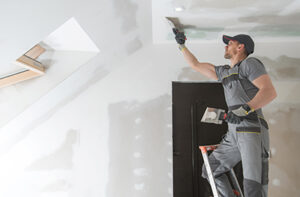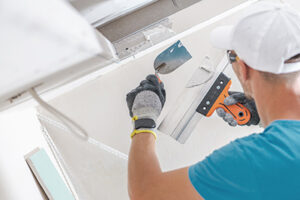Plaster Walls vs. Drywall: What You Should Know
Unless you took an active part in helping or watching your home being built, you probably don’t know much about how your walls were built. I was in the same boat until recently. It’s actually more interesting than you may think! It’s also helpful to know more about walls if you are preparing to build a home. There are two main types of walls that are widely used in home construction: plaster and drywall.
What is the difference between plaster walls and drywalls? The biggest difference between plaster walls and drywall is weight. Plaster is much heavier than drywall because it contains bigger particles of rock, so it must be handled by professionals using power tools. Drywall, on the other hand, is light enough for most homeowners to carry and hang themselves with little difficulty.
Another key difference is why they’re used. Plaster is typically used in homes with a historic or architectural value. Drywall, on the other hand, is the preferred type of wall for modern buildings because it’s more affordable and easier to install.
Plaster is made out of lime, sand, and hair. It takes about a month to dry completely and must be sealed to protect the surface from stains and moisture damage.
Drywall is made of gypsum rock and has no texture or pattern on the face layer. If you choose to finish your walls with paint or wallpaper, it’s very difficult to tell that they’re not plastered.
There is so much more to be said about these two types of walls. So let’s dive into it and get all your questions answered!
Differences In Production & Cost
Plaster and drywall differ a lot in how they are produced. Plaster is made from mixing a combination of cement, sand, lime, and hair. It’s then left to dry for about a month after which it can be treated with the appropriate sealer. This means that plaster wall production is more complicated and time-consuming than drywall production.
Drywall, on the other hand, is produced by first crushing gypsum rock into a powder. Then it’s pressed into sheets and shipped to your home or home improvement store. The process is much quicker than that of plaster, which means that the cost will be significantly less.
 Differences In Application
Differences In Application
Whether you are starting the process of building a home, or you want to renovate an existing one, your walls are an important part of that process. The application of plaster and drywall are very different, here’s how:
Plaster walls are typically finished by applying coats of plaster onto the walls with trowels. This can be done by hand. However, it’s much easier to do with power trowels. It is typical for trowel work to leave texture on the wall which can provide an interesting look when combined with paint or wallpaper.
Drywall application is much easier because there’s no need to worry about texture or patterns. To install drywall, you simply need to attach it with screws or nails to your home’s internal frame.
Differences In Texture
Texture is an important difference between plaster walls and drywall. Plaster walls can be textured, which means that they have a pattern or relief on the surface.
Drywall, on the other hand, does not include any texture or pattern on the face layer. Drywall is smooth and can be painted or covered with wallpaper to suit your aesthetic tastes.
Sealing & Cleaning
After one or the other has been installed, there are some differences in the care and cleaning of each. Here are a few quick tips for each:
Plaster walls require special sealants in order to protect them from moisture damage and staining. All sealants are not created equal, so you’ll want to do some research on this.
Drywall doesn’t require any special treatments or coatings, but it can be damaged by moisture if there is no defense against it. So look into board and batten siding as an alternative to help improve the drywall’s ability to resist moisture.
As far as regular cleaning while living in your home, plaster walls require less maintenance. This is because drywall can be scratched and dented by furniture and decorative items, while plastered surfaces do not normally get damaged.
 The Purpose of Plaster or Drywalls
The Purpose of Plaster or Drywalls
While this article is about the differences between plaster walls and drywalls, both have a shared purpose – to cover your home’s internal frame. Without either one, you wouldn’t be able to keep temperatures consistent or protect surfaces from moisture damage.
In short, plaster walls and drywalls are simply different ways of protecting your home from the elements. While one is more expensive than the other because of their complicated production process, both provide equal protection for your living space.
Advantages Of Plaster Walls
Plaster offers a lot of benefits that drywall doesn’t. They include:
- Plaster is more affordable than drywall. It is around half the price of gypsum drywall.
- It is more versatile in terms of aesthetics and design. You can use many different types of finishes with plaster, including paint and wallpaper.
- Plaster walls are more moisture-resistant than drywall.
Disadvantages Of Plaster Walls
Plastering is a lot of hard work and there are some disadvantages to plaster walls including:
- It takes time to apply the layers of plaster, which means that it can be quite labor-intensive.
- Since each layer has to be allowed time to dry, you have to wait around for the plaster to be ready.
- It can uneven if done by an unskilled worker so it’s important that the installer is qualified to do the job correctly.
Advantages Of Drywall
Drywall also has some advantages if that’s the route you choose to go! A few of those include:
- It is much faster to install drywall than it is to plaster the walls.
- Drywall does not require as much labor as plastering.
- It is more affordable than plaster. In fact, drywall costs around half of what a gypsum wall would cost.
- The finish is smooth, which means that it is a good surface on which to paint.
Disadvantages Of Drywall
Of course, drywall also has some drawbacks compared to plaster walls. The most notable of those include:
- Drywall can be damaged by moisture if there’s no protective coating or barrier to protect it. So this means you should expect to need a moisture barrier and a good coat of paint before finishing the walls with paint.
- Drywall doesn’t have any texture, which means it’s harder to make it look interesting, especially if you want a decorative or textured look.
- It can be stained by colored fluids, so you have to maintain it regularly to prevent staining.
Is Drywall A Modern Thing?
One common misconception is that drywall was a modern invention. People often think it’s a new construction material but it has actually been around for over 500 years – just not as we know it today.
In the early 1900s, several American companies started to produce a popular brand of gypsum drywall that is still being used today.
The first patent for gypsum drywall was submitted in 1918 by two men from Ohio, John Henry Stark, and Edward Oscar Smith. They sold their invention to the United States Gypsum Company.
Over time, further advancements were made to create the drywall that is used today. The drywall that is most used now is a homogeneous, lightweight product made from gypsum plaster and calcium sulfate.
 Were All Historic Buildings Made With Plaster?
Were All Historic Buildings Made With Plaster?
Now that we know drywall isn’t necessarily a new thing, what about plaster? The truth is that there have been a lot of historic buildings, even those from the past few hundred years, that was not made with plaster.
Many old houses were built using wattle and daub as insulation, which involved placing twigs or branches inside wood panels to serve as an insulator. Other older houses were built without insulation at all.
It was only when the industrial revolution came along that houses started to be built using plaster or drywall. In these industrial times, workers were in short supply so the demand for new building techniques grew quickly.
Plaster and gypsum drywall became a popular option because they were fast and efficient- two qualities required by everyone attempting to get more work done with fewer people.
Why Are Plaster Walls Still Used Today?
If you have noticed throughout this article, it seems like drywall is the way to go. Then why isn’t plaster a thing of the past?
One reason why plaster walls are still used today is that there are people who still prefer the look of a textured wall. That’s not surprising since it can be hard to match the decorative appeal of a real texture in a space.
Besides that, some people also choose plasters walls because they offer greater acoustic benefits than drywall. A plaster wall with a thick coat of paint can add some soundproofing to a space, making it an ideal choice in rooms that need to be quiet.
In Conclusion
So now you know the difference between plaster walls and drywalls! Your home must have one or the other. You can’t have a beautiful, decorative finish if you don’t plaster your walls and you can’t cut costs for home repairs without drywalls. Either way, both plaster, and drywall are great choices – it just depends on what you want and need. Thanks for reading!
